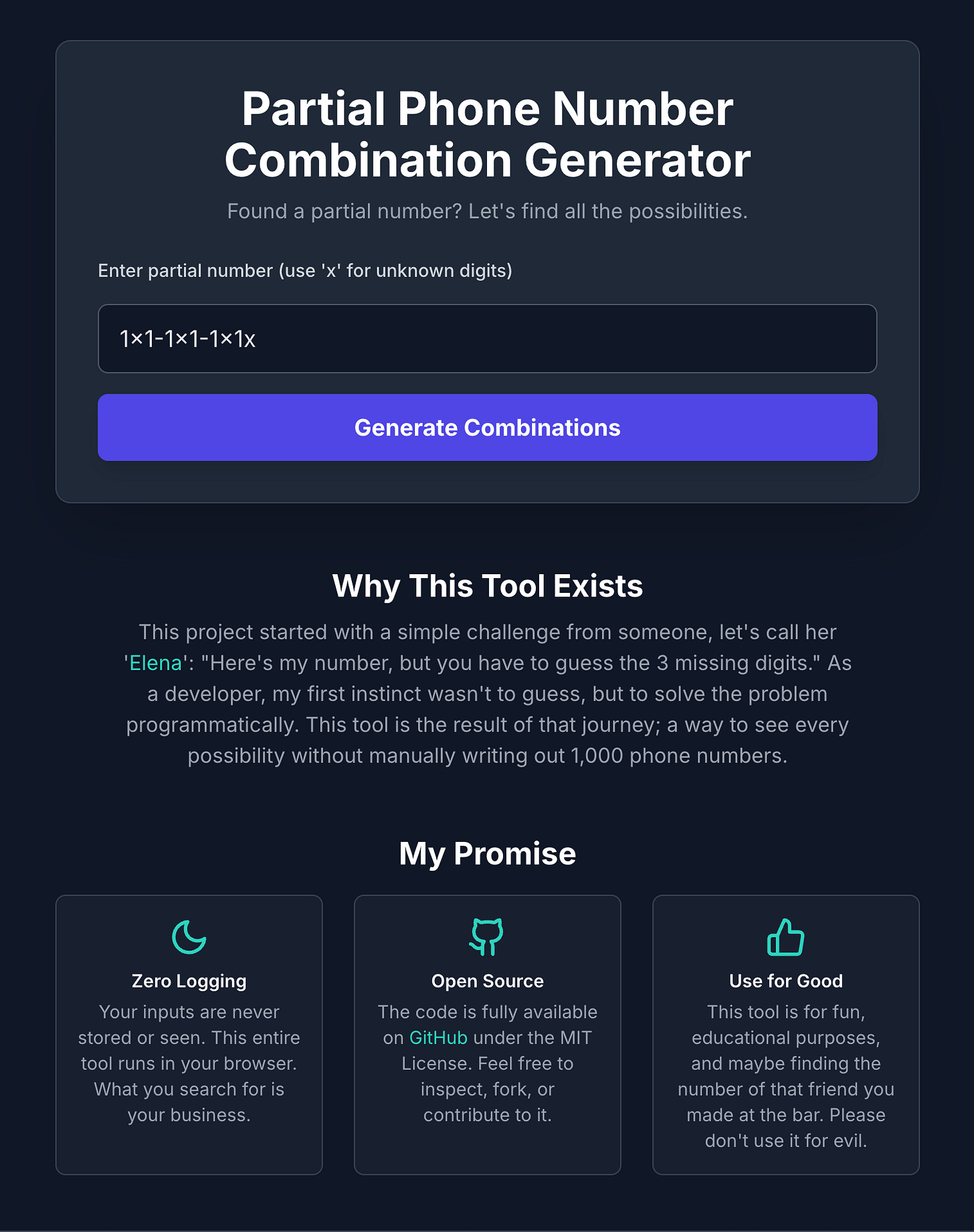The Elena Project: Accidental SIGINT and Lean Product Engineering
https://50221337.xyz - Partial Phone Number Combination Generator
First and foremost, I am a builder. So when a friend, we'll call her "Elena", gave me her number with three digits missing and said "guess," (the three digits) my mind didn't see it as a social game. I saw it as a data problem with a clearly defined scope: a search space of exactly 1,000 possibilities. For a product-minded engineer, the most logical first step isn't to guess; it's to build a system that solves the problem definitively.
My initial approach was to architect the simplest possible solution. I wrote a quick Node.js script with a recursive function to generate every valid combination. In milliseconds, I had a complete list. This was my MVP, a proof-of-concept that successfully addressed the core challenge. But as any builder knows, solving the initial problem is rarely the end of the story. The real engineering challenge begins when you ask, "How can I automate this, end-to-end?"
That single question sent me down a rabbit hole, forcing me to architect a hypothetical and, as it turns out, highly illegal, surveillance product. My first consideration was the data acquisition pipeline. Manually dialing 1,000 numbers is inefficient. The clear solution was a programmable voice API. A service like Twilio could be scripted to systematically dial every number, but that introduced a new problem: handling the 999 wrong numbers. This led me to a feature called Answering Machine Detection (AMD), a crucial component that could filter the calls, allowing the system to hang up on human answers and only engage with voicemail greetings. With this, the architecture evolved: it was now a targeted, automated system designed to record only the relevant audio samples.
The final piece of the puzzle was analysis. With a collection of voicemail recordings, how would I identify the target? This required a more specialized tool: a voice biometric API. Services from companies like Veridas or Aculab provide the technology to create a "voiceprint", a unique, mathematical representation of a person's voice. My theoretical system design was now complete: enroll a known voice sample of "Elena," then programmatically compare that voiceprint against every voicemail recording to find a match. I had, in theory, architected a fully automated SIGINT (Signals Intelligence) operation.
It was at this point that a critical, non-technical constraint entered the picture: legality. Any real product engineer or founder has to think several steps ahead, considering not just technical feasibility but also market, financial, and legal risks. A quick search into Canadian telecommunications law revealed that my clever design was, in fact, a blueprint for committing multiple federal crimes, namely the interception of private communications under Section 184 of the Criminal Code. The project, as architected, was dead on arrival due to a complete failure in compliance.
This is where the pivot happened. The goal was never to build an illegal surveillance tool; it was to solve the initial problem. The most intelligent architectural decision was to return to first principles. I abandoned the complex, server-side surveillance model and embraced the philosophy I use for my real SaaS projects: build a lean solution that offloads as much as possible to the client side.
The result is 50221337.xyz, a tool that is not only legal but also more elegant. It's a "zero-liability" architecture. The entire application; the logic, the generation, the display, runs in the user's browser. There is no backend, no database, and therefore, no logging and no privacy concerns. It's a stateless application that perfectly solves the user's problem without creating any risk or overhead for the builder. I deployed the static site on Vercel, configured the custom domain, and implemented SEO best practices; taking it from a local script to a live, global product.
What started as a joke became a journey into the creation of a product. It's a real-world example of identifying a niche problem, architecting a solution, hitting an insurmountable constraint, and pivoting to a lean, valuable, and shippable product. It's not just about writing code; it's about building systems that make sense; technically, ethically, and financially.
And yes, in the end, I just asked for the number. She gave it to me.
Thank you, "Elena" ;)
Follow me on GitHub: DevChthonic
Business or job opportunities? Email me: devchthonic@protonmail.com
I'm a self-taught, full-stack product minded engineer with both venture-backed and bootstrapped startup experience. I build from first principles; lean, fast, and built to last.
I don’t just write code: I build products that make business sense. I architect for value, design with user outcomes in mind, and optimize for cost, scale, and long-term ROI. Whether it’s high-level product strategy or debugging infrastructure in a Linux shell, I do what needs doing. If I don’t know how, I learn what needs to be learnt.
My Solo Stack
These are the core tools and technologies I use daily to build full-stack products:
Frontend: HTML, CSS, JavaScript, React, Vue, Svelte
Backend: Node.js, Express
Databases: PostgreSQL, MongoDB (NoSQL)
DevOps: Linux, Docker, Git
Hosting: Supabase, Render, Vercel
I have a two million dollar failure story too. Ask me about it in a job interview.
~ Chthonic, June 18 2025






